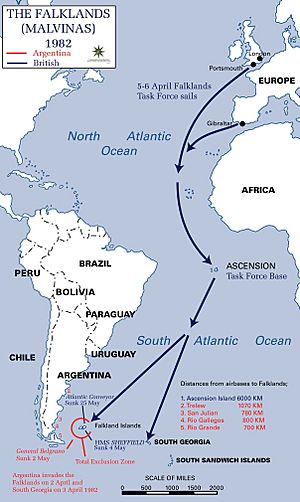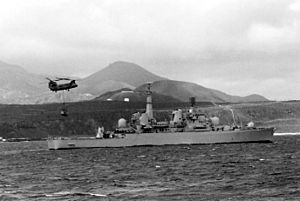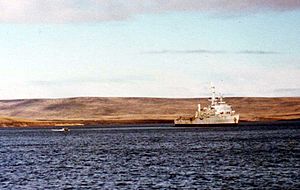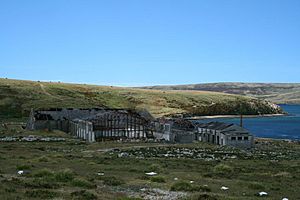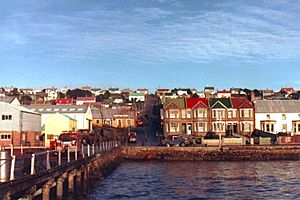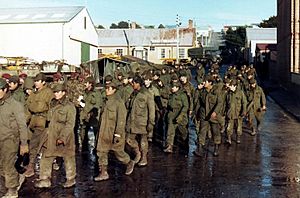British logistics in the Falklands War facts for kids
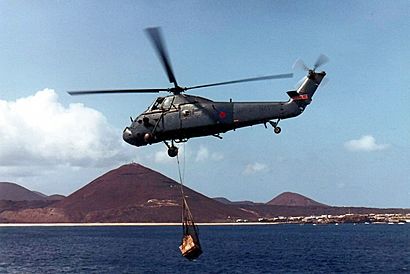
The 1982 Falklands War was a conflict between Britain and Argentina over the Falkland Islands. Britain launched a huge military operation to take back the islands. This mission needed a very complex system to move supplies, equipment, and people, known as logistics. It was a massive challenge because the islands are about 7,000 nmi (13,000 km) from the UK.
Argentina invaded the Falkland Islands in April 1982. At that time, the Royal Navy had fewer ships that could carry troops and equipment. However, they still had important ships like the aircraft carriers HMS Hermes and Invincible. They also had landing ships like HMS Fearless and Intrepid, and six other landing ships. To get enough supplies to the Falklands, the Royal Navy also used many civilian ships. These were called ships taken up from trade, or STUFT.
The British military set up a main base on Ascension Island. This island is in the middle of the Atlantic Ocean, about 3,700 nmi (6,900 km) from the UK and 3,300 nmi (6,100 km) from the Falkland Islands. Ascension Island had a great airfield, but not much space for planes or port facilities. It was used to get ships ready and as a base for Hercules transport planes. These planes were changed to carry extra fuel and could be refuelled in the air. This allowed them to deliver important supplies to the South Atlantic.
British troops, mainly the 3rd Commando Brigade, landed at Ajax Bay, Port San Carlos and San Carlos on East Falkland. But they had trouble getting supplies because Argentine aircraft kept attacking British ships. A ship called SS Atlantic Conveyor was hit by missiles and sank. It carried three Chinook and six Wessex helicopters, along with tools and other vital supplies. Losing these helicopters meant the troops had to march long distances across East Falkland. Despite these challenges, British forces won the battles around Port Stanley, and Argentine forces surrendered on 14 June.
Contents
Why Logistics Mattered in the Falklands War
The Falkland Islands (also called Malvinas) had been disputed between Britain and Argentina for a long time. Tensions grew quickly in March 1982. On 2 April, Argentine forces invaded and took over the islands.
Britain responded by sending submarines and supply ships to the South Atlantic. The Prime Minister, Margaret Thatcher, ordered a special force to take back the islands. This operation was called Operation Corporate. Admiral Sir John Fieldhouse was in charge of the main Task Force 317.
The landing force was led by Brigadier Julian Thompson. His force was built around the 3rd Commando Brigade. This group included three battalions of Royal Marines and their own support units.
How Ships Were Used for the War
Amphibious Ships: Getting Troops Ashore
On 2 April, the Royal Navy got its two aircraft carriers, HMS Hermes and Invincible, ready to sail. They were in port for maintenance, but were quickly prepared. The two landing platform dock (LPD) ships, HMS Fearless and HMS Intrepid, were also made ready. These ships could carry landing craft inside them.
Britain also had six Round Table-class landing ship logistics (LSL) ships. Four were ready right away. These ships were crucial for carrying heavy equipment and vehicles.
These military ships were not enough for a war so far from home. So, the British government decided to use civilian ships. This was done by requisitioning them, meaning they took them over for military use. This hadn't happened since 1956. These civilian ships were called STUFT (Ships Taken Up From Trade).
Many modern ships are built for specific jobs, which made them less flexible for war. For example, ferries couldn't carry enough fresh water for a long trip. Only one out of every four ships inspected was taken. In total, 54 ships were used. They carried 100,000 tons of cargo, 95 aircraft, 9,000 people, and 400,000 tons of fuel.
One important ship was the ocean liner SS Canberra. She was on a cruise but was quickly chosen to carry troops. Another ferry, MV Norland, was also used. For vehicles, roll-on/roll-off ships like MS Elk were preferred. The container ship SS Atlantic Conveyor was turned into an aircraft transport.
Later, the British Army's 5th Infantry Brigade was also sent. The famous liner SS Queen Elizabeth 2 was used to carry these troops. More roll-on/roll-off ships and another aircraft transport, SS Atlantic Causeway, were also brought in.
Logistical Support: Fuel, Water, and Repairs
Fuel was very important for the task force. Britain couldn't get fuel from South America or South Africa for political reasons. So, they relied on their own tankers and requisitioned fifteen more civilian tankers.
Many civilian ships didn't have systems to make fresh water. So, the SS Fort Toronto was used as a water tanker. The SS Stena Seaspread became a repair ship. Several tugboats were also brought in to help.
Britain didn't have dedicated hospital ships. Instead, the P&O liner SS Uganda, which was on an educational cruise, was turned into a hospital ship. It had 250 beds and a team of 135 medical staff. Other survey ships like HMS Hecla became ambulance ships. Hospital ships are protected under the Geneva Conventions, meaning they cannot be attacked.
Dockyards: Getting Ships Ready
The Royal Navy's dockyards were very busy preparing ships. These included Portsmouth, Devonport, and Gibraltar. Many of these dockyards had faced cutbacks, but now they were working non-stop.
Some ships needed major changes. For example, Atlantic Conveyor had to have container tie-down points removed. A landing pad for helicopters and Harriers was added. New radio and satellite systems were installed. The conversion of Uganda into a hospital ship was done in just 65 hours.
About 17 ships were fitted with helicopter landing pads. On Canberra and Queen Elizabeth 2, even the swimming pool areas were used because they were strong enough to hold the weight of helicopters.
The Royal Marines needed to quickly load their supplies. About 150 trucks helped move stores from depots on the first day, and 1,500 trucks were used in total. They moved one million operational rations and 10,000 tons of ammunition.
Ships were not loaded in a way that made the most important items easy to get to first. This is called "combat loading." So, critical equipment was often at the bottom of the holds. For example, Baltic Ferry had ammunition deep inside that could only be reached by removing everything else.
Most wheeled vehicles were left behind because they weren't expected to work well on the islands. Instead, the 3rd Commando Brigade took 75 Bv202 tracked vehicles. These vehicles were brought from Scotland by train. All vehicles were loaded with full fuel tanks and extra fuel cans, which is usually not allowed due to fire risk.
Ascension Island: The Mid-Atlantic Hub
Ascension Island became a vital base. It was a British territory but had a US airfield. The US allowed British forces to use its facilities. The island had a long runway but limited space for parking planes. There was an anchorage but only one small jetty.
RAF Lockheed C-130 Hercules transport planes flew to Ascension on 3 April, bringing supplies and personnel. The British Forces Support Unit (BFSU) grew to over 800 people. They started using Westland Sea King and Wessex helicopters.
Fuel was a challenge. The US controlled the fuel storage. They allowed Britain to use some of their fuel, but it quickly ran low. More fuel tankers arrived, and the US released its reserve stocks. Engineers built a pipeline to move fuel from the port to the airfield.
The RAF presence increased sharply. Hawker Siddeley Nimrod patrol aircraft, Handley Page Victor refuelling tankers, and Avro Vulcan bombers arrived. The Vulcan bombers even flew missions to the Falkland Islands from Ascension.
The number of people on the island grew to about 1,000. This put a strain on the water supply. Portable living units were flown in to house the extra personnel.
When ships arrived at Ascension, they took the chance to rearrange their equipment. This took eleven days. Helicopters were essential for moving supplies between ships and on the island. Shortages of lifting gear and cargo nets made the work harder.
To allow planes to be resupplied in the South Atlantic, Hercules aircraft were modified. They were fitted with extra fuel tanks to extend their range. They also got refuelling probes from Vulcan bombers, allowing them to be refuelled in the air by Victor tankers. This was the first time propeller planes were refuelled by jet tankers.
Special teams prepared high-priority supplies for airdropping from Hercules planes. These airdrops delivered supplies to ships at sea and even to troops on the Falkland Islands. Sometimes, personnel were also parachuted into the sea to be picked up by ships.
Landing and Moving Supplies on the Falklands

IR = Infantry Regiment; Cdo = Commando; SAS = Special Air Service; SBS = Special Boat Squadron; M&AW = Mountain and Arctic Warfare Cadre
The Landing at San Carlos
The plan for the landing, called Operation Sutton, changed to spread out the troops. This meant that different battalions were carried on separate ships. On 19 May, troops were moved between ships using landing craft. Sadly, a Sea King helicopter crashed, and 22 people were lost.
The Commando Logistic Regiment wanted the LSL ships to be beached (driven onto the shore) for quick unloading. But this was risky for the ships. So, the LSLs unloaded onto special landing rafts and craft through their stern doors. This made unloading slower.
The logistics plan was for support teams to stay on ships at first. After the landing area was safe, they would join their units. A Brigade Maintenance Area (BMA) was set up near Ajax Bay to manage supplies.
Medical support was also planned. Field hospitals were set up ashore. Injured soldiers could be flown to the hospital ship Uganda.
The landing force entered Falkland Sound on 21 May. Troops landed at San Carlos Water (Blue Beach), Ajax Bay (Red Beach), and Port San Carlos (Green Beach). They secured the high ground.
Building Up Supplies
Once daylight came, helicopters started moving supplies. On 21 May, helicopters moved 288 loads, including 520 people and 220 tons of supplies. Civilian ships were slower to unload than military landing ships.
Priority was given to moving the six light guns and their ammunition ashore. This needed 85 Sea King helicopter flights. Air defence systems, like Rapier missiles, were also quickly moved to high ground. Argentine air forces attacked ships in Falkland Sound, and two Gazelle helicopters were lost.
Several British escort ships were hit by bombs. The commander decided it was too dangerous for civilian ships to stay in Falkland Sound. On 23 May, Argentine bombs also hit the LSLs Sir Bedivere, Sir Galahad, and Sir Lancelot. None of the bombs exploded, but Sir Galahad caught fire and was put out of action. This disrupted the supply plan.
The BMA at Ajax Bay was not ideal. The ground was rocky, limiting space for supplies. The only shelter was a disused refrigeration plant, which became a field hospital.
The field hospital was set up in the refrigeration plant. They didn't paint a Red Cross on the building because it was near ammunition stores. They called it "The Red and Green Life Machine." They treated 1,205 men, and only 3 died.
The Atlantic Conveyor was hit by an Exocet missile on 25 May and caught fire. It was a huge loss. Twelve people died, and three Chinook and six Wessex helicopters were destroyed.
The one remaining Chinook helicopter became incredibly important. It flew 109 hours without maintenance, carrying 1,500 troops, 95 wounded, 650 Argentine prisoners, and 550 tons of cargo. It even survived flying into the sea one night!
The Atlantic Conveyor also carried four tent camps for 4,500 people, a portable fuelling system, and fuel tanks. All these were lost. Material for building an airstrip was also lost, but engineers built one anyway using other materials. By 27 May, all ships were unloaded.
Marching Over the Mountains
3rd Commando Brigade's Advance
North of the Falklands, the Royal Navy set up a Tug, Repair and Logistics Area (TRALA). Ships could get supplies and repairs there. Supplies for the troops on the islands took at least two days to arrive from the TRALA.
Helicopters were vital for moving supplies. Only four Sea Kings had night vision, so they were saved for night operations. One Sea King was always used to support the Rapier missile batteries.
Getting fuel to the troops was a big problem. Rapier batteries and Bv202 tracked vehicles used a lot of fuel. There was plenty of fuel on ships, but getting it ashore and to the troops was hard. A large collapsible fuel tank was hit by enemy fire. Fuel had to be moved in jerry cans using hand pumps.
An Emergency Fuel Handling Equipment (EFHE) system was set up on 23 May. This allowed aviation fuel to be pumped ashore into collapsible tanks. This meant helicopters could refuel on land, saving time.
Engineers also built an airstrip for Harriers to refuel. The equipment for this was lost on Atlantic Conveyor, but they used other materials. The airstrip was finished on 2 June. It allowed Harriers to fly over 150 missions from 5 to 14 June.
Argentine air attacks started targeting the supply areas. On 27 May, four Skyhawk planes attacked the BMA, killing six men and wounding thirty. The field hospital was hit by two bombs, but they didn't explode. Bombs also hit the ammunition area, causing explosions that lasted all night. Many missiles and mortar bombs were lost.
The Battle of Goose Green showed that the troops were using much more ammunition than expected. By 28 May, the BMA had very little ammunition left. The situation got worse when nearly a thousand Argentine prisoners were captured at Goose Green, as they also needed to be fed.
After the war, Brigadier Thompson noted that many senior officers didn't fully understand the huge logistics needed for a conventional war. Peacetime exercises didn't prepare them for the tough choices of moving men versus moving bullets, food, and fuel.

Troops had to march long distances, carrying heavy loads. This was called a "yomp" by the commandos. Helicopters resupplied them and brought their heavy weapons. A Forward Brigade Maintenance Area (FBMA) was set up at Teal Inlet, and a Distribution Point (DP) at Estancia. Supplies were brought to the FBMA by LSLs and then moved by tracked vehicles or helicopters. A Forward Arming and Refuelling Point (FARP) at Teal Inlet saved helicopters from long trips for fuel.
5th Infantry Brigade's Arrival
The 5th Infantry Brigade arrived on Queen Elizabeth 2 at South Georgia Island on 27 May. To protect the large ship, the troops and cargo were moved to other ships. The infantry were transferred to Canberra and Norland, which then sailed for San Carlos.
Bad weather made the journey longer. The 5th Infantry Brigade's logistics units arrived, including those for maintenance, laundry, and baking. However, much of their equipment was on other ships that left without unloading due to air raid alerts.
The arrival of the 5th Infantry Brigade meant the Commando Logistic Regiment had to support two large brigades, about 9,000 people in total. This was a huge strain, as they were only set up to support 3,000 people.
A small coastal vessel, MV Monsunen, was captured from the Argentinians and used to help with transport for the 5th Infantry Brigade.
The 5th Infantry Brigade advanced on a southern route towards Port Stanley. A second FBMA was planned at Fitzroy. But this area was not as good as Teal Inlet, and the Argentinians held the high ground.
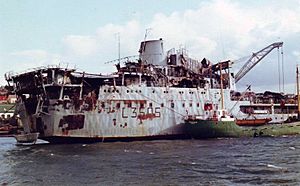
On 8 June, Sir Galahad and Sir Tristram were caught unloading in daylight and attacked by Argentine aircraft. Both ships caught fire. Sir Galahad was a total loss, and 49 men died. This disaster flooded the field hospital with casualties. On the same day, a landing craft was sunk, killing six men and destroying important communications equipment.
For the final battles around Port Stanley, gun positions had plenty of ammunition. More Wessex helicopters arrived, bringing the total to forty. These were used to move ammunition to the gun positions. FARPs at each FBMA helped helicopters refuel.
The final four-day battle was very tough. One artillery battery almost ran out of ammunition, needing an emergency helicopter delivery in a snowstorm. A bridge collapsed, cutting off a supply line, but engineers quickly built a new one. On 14 June, the Argentine forces surrendered.
After the War: Rebuilding and Lessons Learned
After the surrender, British engineers worked to fix Port Stanley. They restored the water supply in four days and repaired the electric grid in a week. Fuel was supplied using a special floating pipeline.
The airfield was unusable because it had been bombed. Engineers repaired the craters and laid down aluminum matting. The runway was too short for some planes, so it was extended. Later, a permanent airbase, RAF Mount Pleasant, was built.
The port facilities were limited. Engineers built new slipways for landing craft. The Ministry of Defence continued to charter many ships to supply the islands. A large floating wharf and warehouse complex was built in 1984.
British forces also had to feed the civilian population and 11,848 Argentine prisoners. The prisoners were quickly sent back to Argentina.
A bakery section started baking bread in the Falklands, making up to 6,000 loaves a day. Troops eventually got fresh food. A military hospital wing was opened in Port Stanley.
About 3,000 tons of British ammunition and over 4.5 million rounds of Argentine ammunition were collected from battlefields. Some British ammunition was sent back to the UK. Most Argentine equipment was dumped at sea.
The first British units returned home in June. The 5th Infantry Brigade's support was combined into the Falkland Islands Logistic Battalion. New commanders arrived, and troops were rotated out.
New living quarters were built for the soldiers, including "coastels," which were floating accommodation vessels.
A special unit arrived to deal with the fallen soldiers. For the first time, families could choose to have their loved ones' remains returned to the UK. An Argentine Military Cemetery was also established near Goose Green.
What Was Learned from the War
The Ministry of Defence learned important lessons from the war. They saw that a huge amount of ammunition and missiles were used. They also learned how much logistical support is needed for operations far from home. Civilian resources were very important. Aerial refuelling was also shown to be very useful.
The value of the Royal Navy's amphibious forces was re-evaluated. A replacement for the lost Sir Galahad was ordered. Other ships were bought or kept for future use. The importance of STUFT was recognized, and these civilian ships continued to be used in other conflicts.
Other countries, like China and the United States, also studied the Falklands War. The Americans were impressed by how quickly Britain could send its forces. They invested billions of dollars in new logistics ships.
Many of the logistics lessons were not new, but they had been forgotten. These included problems with planning, loading ships, and managing fuel and ammunition. There was also a lack of heavy-lift helicopters and land transport. Experts said that peacetime training needed to be more realistic to prepare for real war conditions.


